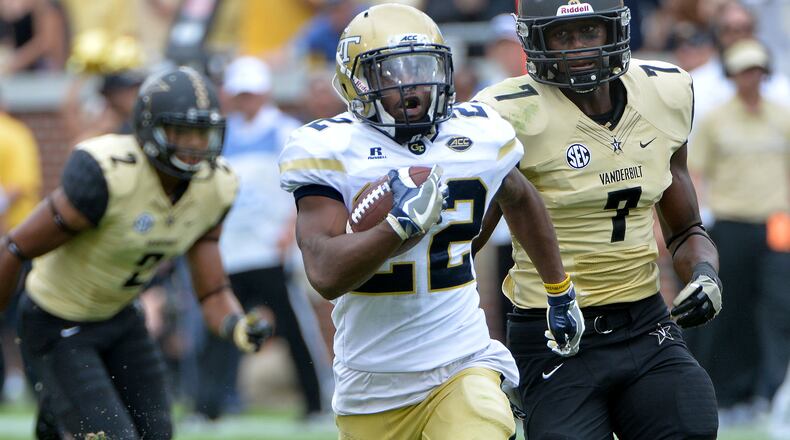As Georgia Tech athletic director Todd Stansbury conducts talks to determine the athletic department’s next apparel provider, his mission is straightforward — to gauge the interest of Adidas, Nike and Under Armour and their ability to help the Yellow Jackets establish their brand.
In his recent podcast, Stansbury said that all three companies bring something different to the table.
“And their vision of where you are, what your brand is, where they envision you lining up in their complement of schools, is all very, very important,” he said. “And depending on their situation and kind of the programs they already represent, all create different dynamics on, one, maybe their level of interest, as well as where you may line up as far as being a priority for them.”
So what is a shoe company paying for?
In short, a few things. The primary value is the licensing agreement, with which companies can exclusively produce a school’s jerseys and other apparel to sell to fans. Often, sports marketing expert Jonathan Jensen said, the contracts allot the companies 85 to 90 percent of the revenue off items they produce with the schools’ logos on them.
“Part of the reason why these deals are so attractive for Nike, Under Armour and Adidas is that in a lot of instances, these deals end up paying for themselves on licensing revenue that comes back to the brand,” said Jensen, an assistant professor in North Carolina’s program of Sport Administration.
That being the case, schools with the largest fan bases typically have the largest contracts, as their sales potential is greater. Three schools with the largest apparel contracts, Michigan, Notre Dame and Texas, ranked first, third and fourth, respectively, in a 2014 ranking of schools by licensing royalties received from merchandise sales. Tech was 50th.
“I think when you look at the three, their priority is retail, and, in fact the reason that they do these deals is because of retail,” Stansbury said on his podcast.
The success of the schools’ teams — and the consequential exposure that the winning brings — also is part of the purchase price. Whenever a team plays on television, with the apparel maker’s logos affixed across the uniforms and shoes/clears, the broadcast becomes a virtual commercial for that company and often can replace the need to buy advertising time, Jensen said.
The value of this exposure is underlined in apparel makers’ contracts with schools. Tech’s contract with Russell Athletic, which expires in June 2018, includes a clause common in apparel deals regarding distribution of gear after a championship such as the ACC championship, NCAA Tournament Elite Eight and national championship games and bowl games. The contract grants Russell the “exclusive right” to distribute T-shirts, hats and other gear celebrating the victory in the venue, gear that often gets exposure in the TV broadcast.
Imagine the buzz, if Tech’s new apparel provider were to begin outfitting the Yellow Jackets this year, that could be created by a new uniform debuted in the season opener against Tennessee on Labor Day in a prime-time slot on ESPN. That’s what apparel makers are paying for and trying to capture.
It’s one reason why Under Armour made such a big investment in UCLA and Cal in 2016. The company wanted a presence in California, to have its logo seen by a section of the country that it was trying to reach.
In the case of Tech, Stansbury said that the three potential partners would be gaining a school with an alumni base and reputation that spans the globe, as well as a base in the Atlanta market.
With a smaller fan base and football and basketball teams that aren’t consistently playing in national-spotlight games, Tech won’t command the deal that powerhouses like Clemson ($2.9 million annually) or Georgia ($4.1 million) have, both with Nike.
Jensen and his colleagues at the Center for Research in Intercollegiate Athletics at UNC developed a predictive model for the value of apparel contracts that incorporated the number of athletes in an athletic department, its average football attendance and total number of NCAA Tournament appearances by the men’s basketball team. By that formula, Tech’s value for the 2016-17 year was $2.1 million, ranking 47th nationally. That’s in line with Tech’s contract with Russell. The contract for this past academic year paid Tech $2.3 million ($1.35 million in cash, $950,000 in gear).
Interestingly, of the top 10 schools that Jensen’s model deemed the most overpaid, eight were contracted with either Adidas or Under Armour. Meanwhile, the 20 most underpaid schools were all aligned with Nike.
It would suggest that athletic departments perceive that Nike brings extra value to a partnership, likely the power and prestige of the Nike brand and its broad appeal to recruits, and also that Adidas and Under Armour have had to overspend to persuade schools to give that up.
In the case of Tech, it could leave Stansbury in a position of deciding whether to take more money from either Adidas or Under Armour or less from Nike. Given Under Armour’s recent buys of more prominent programs such as Notre Dame, Wisconsin and UCLA, as well as its partnerships with Auburn and South Carolina, the Baltimore-based company may not be as eager to spend on Tech.
Tech is in need of revenue — Stansbury has said he believes the annual budget needs to grow by $10 million — and branding power. By offering exposure and an avenue to sell apparel to fans, Tech can get one or the other, but perhaps not both.
About the Author




